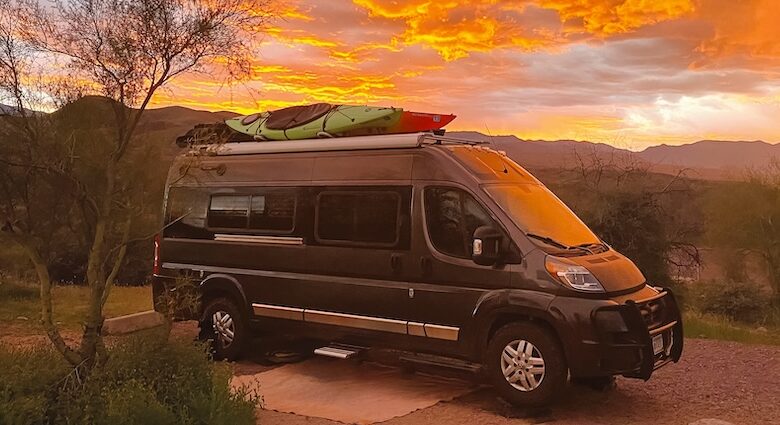Class Bs Spark Interest in Single-Fuel Solutions
The recent popularity of the van-life market has bolstered interest in simplified fuel sources for RVs.

It’s safe to say that the RV industry experienced a surge in interest five years ago. RV ownership increased during the pandemic, and those in the industry welcomed the growth with open arms.
One RV type in particular, the Class B, experienced renewed interest during that period of growth, thanks in part to individuals seeking to go off-grid and a resurgence in the “van-life” trend. A term that first gained popularity in the 1960s and 1970s, van-life has evolved over the past several decades and is now synonymous with the Class B motorhome.
“Class Bs tend to be smaller and more maneuverable, which makes them ideal for traveling to less populated areas or going off the grid,” says Nick Dunning, head of business development, Truma North America. “This type of RV proved ideal during a time when RV travel evolved and grew exponentially.”
Fast-forward five years after the pandemic, and while the industry landscape has changed, RV ownership continues to evolve.
Maximizing Time & Space
According to a recent study by Go RVing and the RV Industry Association (RVIA), current RV owners typically use their RV for 30 days per year regardless of the type of RV. This is a 50% increase since the 2021 Go RVing study. In fact, 86% of current RV owners report using their RV as much as or more than expected, which is also an increase from the 2021 Go RVing results.
“People are still looking to go off-grid, perhaps even more so than before,” Dunning says. “Yet now they are thinking beyond the make and size of the RV. They want to ensure that whatever they use for travel is efficient, maximizes space, and ultimately makes the most sense for their lifestyle. Thus, the growing interest in single-fuel solutions.”
Single fuel means eliminating the need for a second fuel source and simplifying the RV experience. Class B models are built on a van chassis powered by gasoline or diesel engines; thus, by including climate control and water heaters that utilize either gasoline or diesel, the RV has a single fuel source.
“The North American market has been transitioning to single-fuel solutions in the Class B market for a few years now,” Dunning says. “This can be seen as a step toward all-electric for the house side of the vehicle, which is also growing in interest among RV owners.”
Dunning states that there are several reasons to consider moving to single-fuel solutions, including that gasoline and diesel are more readily available than propane when traveling. Reducing or eliminating propane reduces weight, thereby adding usable space for other RV features and appliances.

In addition, RV owners can have the ability to camp for longer periods of time, especially if they are also utilizing battery backups and solar to help the appliances in the coach.
Single-fuel options have been an option in the North American market since 2021, Dunning says, referencing the diesel model of the Truma Combi two-in-one furnace and water heater. Last year, the company also introduced the gasoline-powered Combi G, and a new version of the Combi D arrived in North America at the beginning of 2025. This solution is currently only available to OEMs, but it allows manufacturers to switch to single-fuel solutions.
“Many of our OEM partners are familiar with our Combi system, which runs on propane. Since the footprint of the diesel and gasoline versions is the same as the original, it is a simple transition for them,” Dunning says. Single-fuel options allow manufacturers to meet growing customer demand, and with the freed-up space, they can add other amenities.
Outweighing the Challenges
As with any new technology, there are a few challenges. An overall comfort level must be achieved when using a new fuel source, Dunning says. Additionally, suppliers must work to understand how different fuel types respond to environmental factors.
As for owners, the Class B chassis does not allow all fuel to be removed from the fuel tank. Therefore, when the fuel tank is down to approximately one-quarter full, the appliance will no longer be able to pull fuel and operate. While this is a safety mechanism to ensure the owner has sufficient fuel to drive, it is something that owners must become accustomed to.
Still, for many RV owners, the conveniences far outweigh any challenges.
George Larson, one of the original field testers for the Truma Combi G, has since switched to using a Combi G on his Class B and does not shy away from cold-weather camping.
“There hasn’t been a night where we haven’t run the furnace. We would have had to fill our propane tank several times over by now,” Larson says. “The thought of not having to search for a decent source of propane takes away one of the ‘micro’ stresses that come with living on the road.”
Looking ahead, Dunning and his team believe that interest in single-fuel options will continue to grow, largely due to the flexibility they offer.
“Studies such as that from GO RVing show us that remote work and off-grid experiences are growing demographics for the industry and an exciting opportunity for manufacturers to provide solutions that are simply better for the end user,” Dunning concludes.

